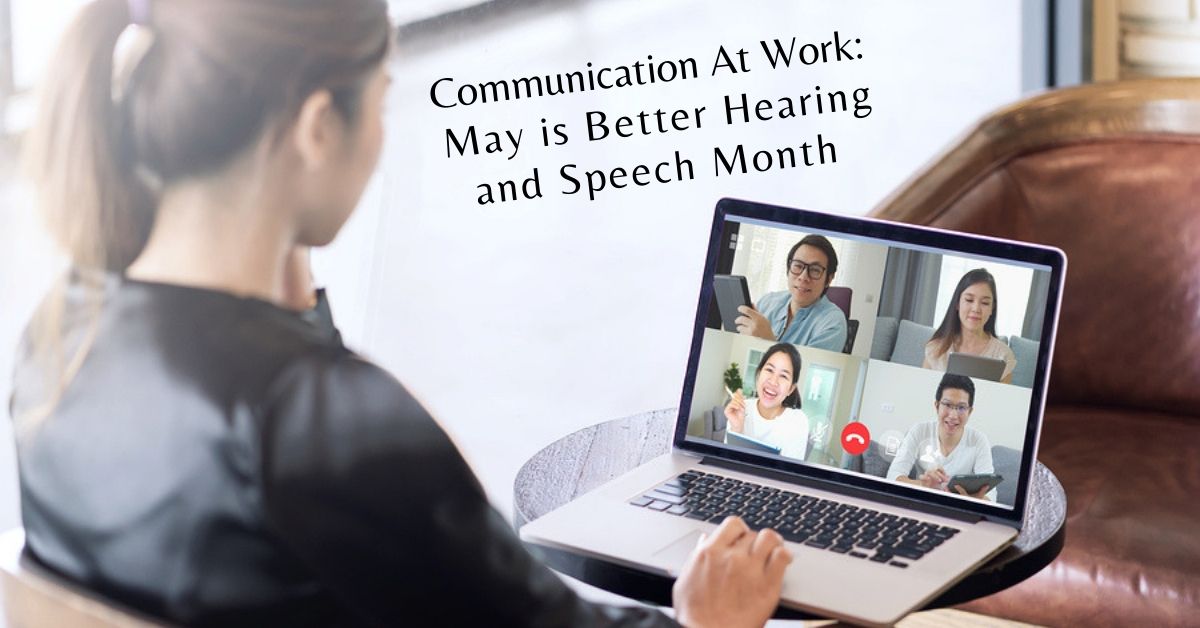- Working with Hearing Loss - May 26, 2023
- Earbud Use Could Harm Your Hearing - May 19, 2023
- Why Pretending to Hear Doesn’t Help - May 2, 2023
The American Speech-Language-Hearing Association (ASHA) marks May as Better Speech and Hearing Month each year. This campaign aims to normalize communication disorders and advocate for more visibility of a variety of communication barriers in our society, such as hearing loss. By removing the stigma of hearing loss, the ASHA seeks to increase access, awareness, and education that encourages people struggling with hearing loss to achieve their career and life goals.
This year’s theme is “Communication at Work,” and it seems a good time to talk about how we can improve one of the most common features of the office job – the meeting.
Better communication ensures better work
Most jobs rely upon a fluid-running team that communicates clearly and frequently. If people can not receive information and act accordingly, their performance will suffer. Some may seek help, but an alarming finding from a recent study suggests that those with hearing loss are more likely to delay treatment by up to seven years because of the stigma attached to wearing a hearing aid.
As Sergei Kochkin, Ph.D., Better Hearing Institute’s executive director has shown, this hesitation impacts earning potential. His study found that average salaries fall accordingly when the severity of untreated hearing loss increases. Unfortunately, this means that those who have the most severe hearing loss stand to earn the least amount of $30,000 less than those who regularly hear.
Tips for better meetings at work
One of the most common times people with hearing loss have difficulty is in the meetings they have at work. Collectively, 15 percent of an organization’s time is spent in meetings, so a lot of time is spent listening to others and having to respond appropriately.
If you have hearing loss, it makes sense to think about how you can improve your chances of effective communication in these situations. Here are some tips to follow:
State your needs to other colleagues. It is always best to be bold when talking to colleagues about your hearing loss. Opening up to them may be awkward at first, but over time, you’ll be happy to have done so. Discuss your hearing loss with them, and how it affects you in meetings. Share communication techniques with them that they can do to help you in meetings, such as making eye contact while speaking, and ensuring only one person is speaking at a time.
Have an agenda. A written program, circulated in advance, makes it easier to follow the meeting. It is necessary to appoint a knowledgeable chair who can ensure that attendees follow the plan and refrain from speaking at the same time.
Consider a quiet, well-lit room. For those with hearing loss, background noise may be unusually disruptive. If you have the choice, make sure to choose a meeting room with relatively little noise to maximize the clarity of sound. If possible, change the lighting so that the faces of those who talk can be seen in case you need to rely on visual indicators for understanding.
Get the best seat in the house. Make sure you’ve got a decent seat where possible, where you have a chair that allows you to see everyone so that you can pick up visual information. If you’re viewing a presentation, sit closer to the speaker so that you’re able to lip read.
Use assistive technology. Many hearing aids can connect to diverse audio sources wirelessly. Voice can be transmitted directly to a hearing aid with the right hearing aid accessory. Employers should also consider creating various visual aids to supplement the discussion, such as infographics and charts. The best way to guarantee you a supportive and accessible space is to talk with an employee about their preferred devices and technological assistance.
Get it in writing. Minutes of the meeting should be posted at the end of the session with any decisions made. That’s helpful if you find anything important that you missed. This may also be in the form of a summary email sent after the meeting to all the participants.
Many common communication difficulties can be improved if a person wears hearing aids, professionally fitted. If you’re unsure of where to start, contact us today. We can test your hearing and fit you with a device that will help you put your best foot forward.

